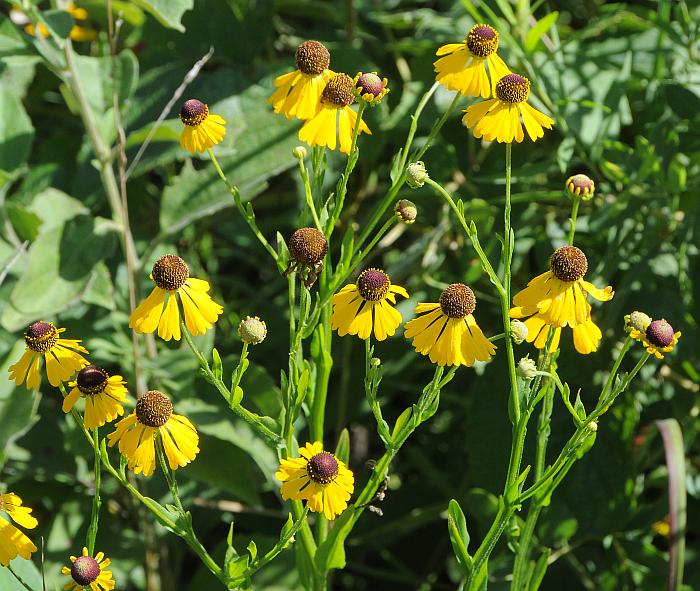Helenium flexuosum Raf.
Southern Sneezeweed

Native
CC = 3
CW = 0
MOC = 58
© SRTurner
Helenium flexuosum Raf.Southern Sneezeweed | |
 |
Native CC = 3 CW = 0 MOC = 58 |
© SRTurner |
|
Family - Asteraceae/Heliantheae Habit - Perennial forb with fibrous roots. Stems - Ascending to erect, to 1.2 m, typically single from base, few-to many-branched above the midpoint, narrowly to broadly winged with decurrent leaf tissue, glabrous or sparsely to moderately pubescent with short, sometimes curved or curled, more or less spreading to loosely ascending hairs, also moderately dotted with sessile to impressed, yellow glands.
Leaves - Basal and alternate, simple, sessile. Blades glabrous or sparsely to moderately pubescent with short, sometimes curved, mostly spreading hairs, also moderately dotted with sessile to impressed, yellow glands. Basal and lowermost stem leaves absent or withered at flowering, not or only slightly smaller than the median stem leaves, the blade narrowly oblanceolate to less commonly narrowly obovate, unlobed or with few to several shallow, rounded, pinnate lobes. Median and upper stem leaves 3-12 cm long, narrowly oblanceolate to oblong-oblanceolate, unlobed, the margins entire or few-toothed, somewhat tapered at the base, long-decurrent as wings of green tissue along the stem, angled or tapered to a usually sharply pointed tip.
Inflorescence - Loose, open clusters or panicles of heads, these appearing long-stalked. Peduncles carinate, densely strigose, scabrous.
Heads - Radiate. Involucre saucer-shaped, the bracts in 2 unequal to subequal series, those of the outer series sometimes fused at the base. Involucral bracts 15-21, 6-18 mm long, 8-18 mm in diameter, the outer series of involucral bracts fused at the base, spreading to more commonly reflexed at flowering, linear to narrowly triangular or narrowly lanceolate, the midnerve inconspicuous or sometimes somewhat keeled, the outer surface moderately to densely pubescent with minute, curved hairs, also moderately gland-dotted. Receptacle strongly convex, hemispherical to nearly globose, often slightly enlarging as the fruits mature, naked.
Flowers - Ray florets 8-13, sterile, the corolla 5-20 mm long, yellow, occasionally with reddish streaks or reddish-tinged toward the base, 5-lobed at apex, tapering to the base, densely pubescent below, glabrous above. Disk to 1.5 cm broad. Disk florets perfect, the corolla 2.5-4.0 mm long, reddish brown to dark purple, usually 4-lobed. Pappus of 5 scales, 0.8-2.0 mm long, the awned tip relatively long. Fruits - Achenes 1.0-1.7 mm long, wedge-shaped, with 5 ribs, the surface brown but this obscured by the often dense, sessile, yellow glands, the ribs moderately to densely pubescent with white hairs. Flowering - June - November. Habitat - Bottomland forests, pond margins, streambanks, ditches, swamps, wet depressions of prairies, fields, pastures, ditches, railroads, roadsides, moist open disturbed areas. Origin - Native to the U.S. Lookalikes - H. autumnale, H. virginicum. Other info. - This species is found in Missouri mostly in the southern half of the state. It is also found throughout the southeastern quadrant of the continental U.S., and also the upper Midwest, where it is considered introduced. The plant is easily recognized by the distinctive appearance of the flowering heads. The disk is nearly spherical, and the ray florets are wedge-shaped and lobed on the ends. Two closely related species, H. autumnale and H. virginicum, appear somewhat similar but have yellow disks instead of purplish-brown. Unlike H. flexuosum, those species also have fertile ray florets. Photographs taken at Bethel Prairie, Barton County, MO., 7-4-03 (DETenaglia); also Shaw Nature Reserve, Franklin County, MO, 7-24-2007 and 8-26-2017, Canaan Conservation Area, Gasconade County, MO, 8-11-2013 and 6-28-2016, and at Allenton Access, St. Louis County, MO, 8-02-2020 (SRTurner). |